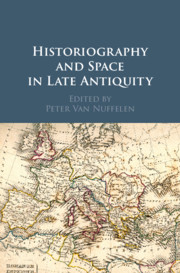Book contents
- Historiography and Space in Late Antiquity
- Historiography and Space in Late Antiquity
- Copyright page
- Contents
- Contributors
- Acknowledgements
- Introduction
- Chapter 1 Constantinople’s Belated Hegemony
- Chapter 2 Beside the Rim of the Ocean
- Chapter 3 Armenian Space in Late Antiquity
- Chapter 4 Narrative and Space in Christian Chronography
- Chapter 5 The Roman Empire in John of Ephesus’s Church History
- Chapter 6 Changing Geographies
- Chapter 7 Where Is Syriac Pilgrimage Literature in Late Antiquity?
- Bibliography
- Index
- References
Bibliography
Published online by Cambridge University Press: 12 August 2019
- Historiography and Space in Late Antiquity
- Historiography and Space in Late Antiquity
- Copyright page
- Contents
- Contributors
- Acknowledgements
- Introduction
- Chapter 1 Constantinople’s Belated Hegemony
- Chapter 2 Beside the Rim of the Ocean
- Chapter 3 Armenian Space in Late Antiquity
- Chapter 4 Narrative and Space in Christian Chronography
- Chapter 5 The Roman Empire in John of Ephesus’s Church History
- Chapter 6 Changing Geographies
- Chapter 7 Where Is Syriac Pilgrimage Literature in Late Antiquity?
- Bibliography
- Index
- References
Summary

- Type
- Chapter
- Information
- Historiography and Space in Late Antiquity , pp. 181 - 212Publisher: Cambridge University PressPrint publication year: 2019



